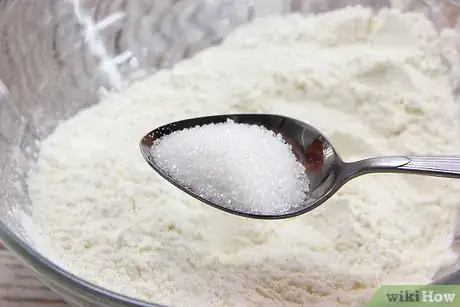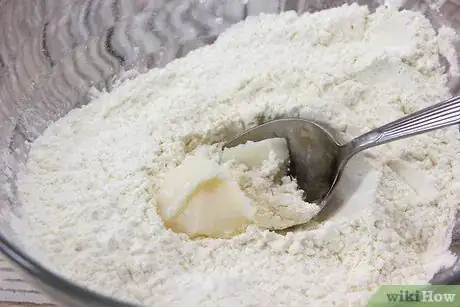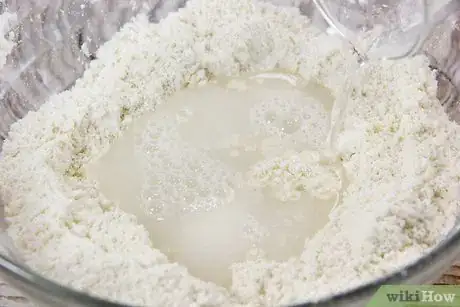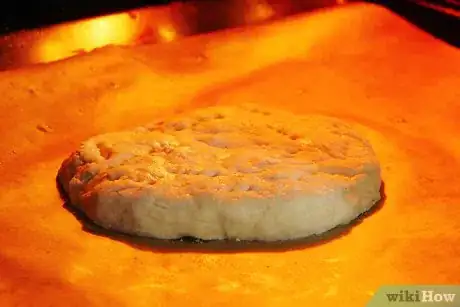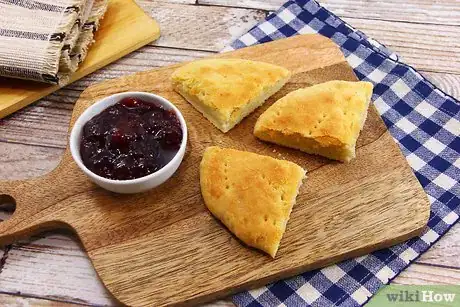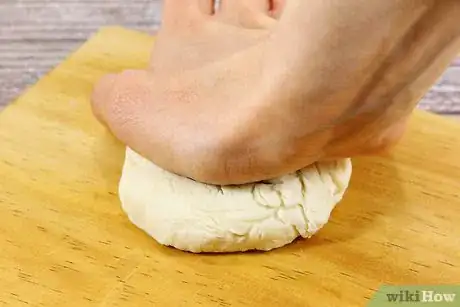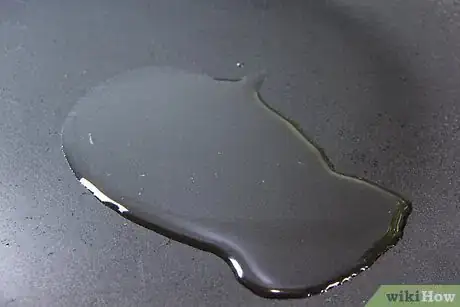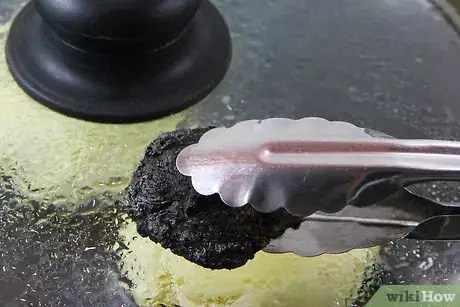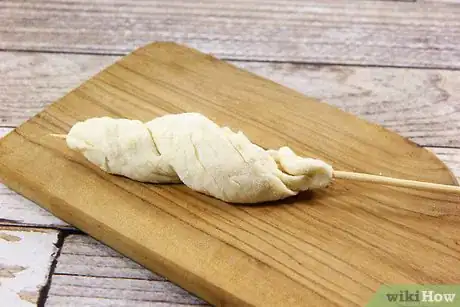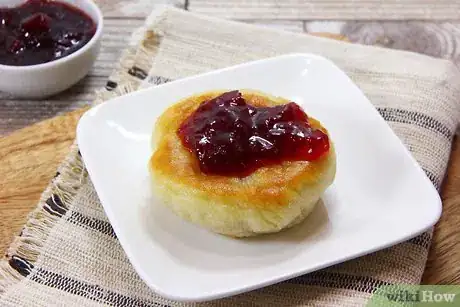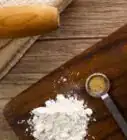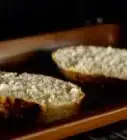This article was co-authored by wikiHow Staff. Our trained team of editors and researchers validate articles for accuracy and comprehensiveness. wikiHow's Content Management Team carefully monitors the work from our editorial staff to ensure that each article is backed by trusted research and meets our high quality standards.
This article has been viewed 125,787 times.
Learn more...
Bannock is a very simple bread that originated in Scotland and was brought to the indigenous people of North America in the eighteenth and nineteenth centuries.[1] It’s meant to be a fast and easy recipe to prepare and is often cooked outdoors over a campfire. You can still cook bannock around your summer campfire, but you can also try baking or frying it at home, too.
Ingredients
Bannock Dough[2]
- 3 cups (384 g) all-purpose flour (white or a mixture of white and whole wheat)
- ½ cup (65 g) powdered milk
- 2 tbsp (29 g) baking powder
- 1 tsp (5 g) salt
- 2 tbsp (25 g) shortening, lard, or butter
- 1 cup (240 ml) water
- 3 tbsp (37.5 g) sugar (optional, for sweeter bread)
- Cooking oil (if frying, for greasing the pan)
Steps
Preparing the Dough
-
1Combine all the dry ingredients in a medium-sized bowl. Add 3 cups (384 g) flour, ½ cup (65 g) powdered milk, 2 tbsp (29 g) baking powder, and 1 tsp (5 g) salt to the bowl. Mix with a whisk until they are well combined.[3]
- You can substitute some of the all-purpose flour for cornmeal or other whole grain (wheat, multigrain, oat, etc.) if you would like a different flavor.
-
2Make a sweeter bannock by adding 3 tbsp (37.5 g) sugar. If you are making bannock for breakfast or want a sweeter treat, add sugar to the mix.[4]
- You can also sprinkle cinnamon and sugar over the finished bread for a great breakfast or brunch treat.[5]
Advertisement -
3Add 2 tbsp (25 g) shortening to the mixture. Fold the shortening into the dry mixture. Combine well until it forms into small crumbles, like breadcrumbs.[6]
- If you plan to make bannock while camping, stop here and place the mixture in a plastic ziploc bag to take with you. When you are ready to make your bannock bread, all you will need to do is add water.[7]
-
4Make a well in the middle of the mixture and pour 1 cup (240 ml) water in. Stir it in gently with a spoon or fork to make a soft ball of dough. You might have to add more water as you stir.[8]
- If you’ve used all-purpose flour, you may need to add a little less water to your dough to get a good consistency.
- If you’ve taken a ziploc bag of bannock mix with you camping, simply pour the water directly into the plastic bag. Reseal the bag and mix the dough together by pressing and squeezing the outside of the plastic.[9]
-
5
Baking in the Oven
-
1Shape the dough into a flat circle 3⁄4 inch (1.9 cm) to 1 inch (2.5 cm) thick. Sprinkle some flour on a clean surface and place the dough on top. Shape it into big, flat circle or oval shape.[12]
-
2Prick the top of the dough in several places with a fork. Piercing the bannock before it goes in the oven will ensure it bakes evenly.
- You can also spread butter all over the top with a basting brush before putting into the oven to give it an extra shine.
-
3Bake at 375 °F (191 °C) for 20-25 minutes. Place your bannock loaf on a clean baking sheet. Bake your bannock in the oven until the crust is golden brown and a toothpick inserted into the top of the bread comes out clean.[13]
-
4Allow the bannock to cool for 10 minutes, then slice and serve it. Take the bannock out of the oven and leave it to cool off. Then, slice it into squares and enjoy it with jam or butter.
Frying the Dough
-
1Break off pieces of the dough and flatten them with your palm. After you’ve kneaded the dough, start to break off fist-sized pieces with your hand. Place them on a clean surface and flatten them gently with the palm of your hand.[14]
- The faster you go from mixing the water in the dough to putting it on the skillet, the lighter your bannock will be.
-
2Heat oil on a cast iron skillet. Pour about 1 tablespoon (15 ml) of oil on a skillet. Heat it on the stovetop or on a grate over a fire.[15]
- The oil in the pan should be hot, but not scalding. If there is smoke coming from the pan, it’s too hot.
-
3Fry the bannock pieces over medium heat. Add a few bannock pieces to the skillet. Fry them until they are golden brown on one side.[16]
-
4Flip the bannock pieces and fry them on the other side. You can use a spatula to flip each bannock piece over to fry the other side. If you don’t have a spatula handy, try flicking your wrist as you hold the skillet to encourage the bannock pieces to flip.[17]
-
5Place coals on the skillet lid to cook both sides simultaneously. If your skillet has a sturdy lid, put it on when you start frying the bannock. Place hot coals on top of the lid to cook the top side of the bannock while the bottom is frying.[18]
- Be sure your skillet is in a stable position above the fire so it doesn’t fall when you put the coals on top.
-
6Try roasting the bannock on sticks if you don’t have a skillet. If you don’t have a skillet handy, you can still cook the bannock over an open fire. Form long strips of bannock around 3⁄8 inch (0.95 cm) thick and 1 inch (2.5 cm) long and wrap each one around the end of a long stick. Hold the bannock over your campfire, rotating them gently, like you are roasting marshmallows.[19]
- You may want to make a thicker dough for roasting over the fire so the bannock strips are less likely to fall off the sticks. Simply add a little less water to the dough.
- You can roast bannock over coals, too.
-
7Drain the bannock on paper towels and serve them warm or cool. Once your bannock is done frying, place them on a paper towel to absorb any excess oil. Enjoy them hot or save them as room temperature snacks for later.[20]
- Store bannock in a cool, dry place wrapped in plastic or aluminum foil, or in an airtight container. Stored properly, it can last up to 2 weeks.
Community Q&A
-
QuestionCan I substitute lard for the shortening?
 Community AnswerYes. After it's done cooking, spread the butter, lard or shortening on top as its cooling so that it softens the bannock.
Community AnswerYes. After it's done cooking, spread the butter, lard or shortening on top as its cooling so that it softens the bannock. -
QuestionCan I use butter instead of shortening?
 Community AnswerYes, butter can be used, but it may alter the crust and crumb.
Community AnswerYes, butter can be used, but it may alter the crust and crumb. -
QuestionCan gluten free flour be used?
 Community AnswerYes. I am gluten free and I make cakes all of the time. The texture may be different depending on the kind/brand of GF flour you use.
Community AnswerYes. I am gluten free and I make cakes all of the time. The texture may be different depending on the kind/brand of GF flour you use.
Things You'll Need
Preparing the Dough
- Medium-sized bowl
- Whisk
Baking in the Oven
- Baking sheet
- Fork
- Basting brush (optional)
Frying the Dough
- Cast iron skillet
- Paper towels
Warnings
- Watch the bannock carefully as it is cooking; you don't want it to burn.⧼thumbs_response⧽
References
- ↑ https://anitalianinmykitchen.com/bannock/
- ↑ https://www.curiouscuisiniere.com/bannock-bread/
- ↑ https://www.curiouscuisiniere.com/bannock-bread/
- ↑ http://50campfires.com/bannock-the-original-camping-bread-unusual-but-delicious-camping-foods/
- ↑ https://www.curiouscuisiniere.com/bannock-bread/
- ↑ https://www.curiouscuisiniere.com/bannock-bread/
- ↑ https://www.artofmanliness.com/articles/baking-in-the-wild-how-to-make-bannock-bread/
- ↑ https://www.curiouscuisiniere.com/bannock-bread/
- ↑ https://www.artofmanliness.com/articles/baking-in-the-wild-how-to-make-bannock-bread/
- ↑ https://www.artofmanliness.com/articles/baking-in-the-wild-how-to-make-bannock-bread/
- ↑ https://www.curiouscuisiniere.com/bannock-bread/
- ↑ https://anitalianinmykitchen.com/bannock/
- ↑ http://www.cookingnook.com/recipe/bannock/
- ↑ https://www.artofmanliness.com/articles/baking-in-the-wild-how-to-make-bannock-bread/
- ↑ https://www.artofmanliness.com/articles/baking-in-the-wild-how-to-make-bannock-bread/
- ↑ https://www.artofmanliness.com/articles/baking-in-the-wild-how-to-make-bannock-bread/
- ↑ https://www.artofmanliness.com/articles/baking-in-the-wild-how-to-make-bannock-bread/
- ↑ https://www.artofmanliness.com/articles/baking-in-the-wild-how-to-make-bannock-bread/
- ↑ http://50campfires.com/bannock-the-original-camping-bread-unusual-but-delicious-camping-foods/
- ↑ https://anitalianinmykitchen.com/bannock/
- ↑ https://www.artofmanliness.com/articles/baking-in-the-wild-how-to-make-bannock-bread/
About This Article
To make bannock, start by mixing flour, powdered milk, baking powder, and salt in a bowl. You can also add some sugar if you want to make a sweet bannock. Next, stir shortening into the mixture until it turns into small crumbles. Then, add water and knead the dough until it has an even texture. Once you're finished with the dough, shape it into a dome and poke it with a fork a few times. Finally, bake the dough for 20-25 minutes at 375 degrees Fahrenheit. To learn how to make bannock by frying the dough, scroll down!

